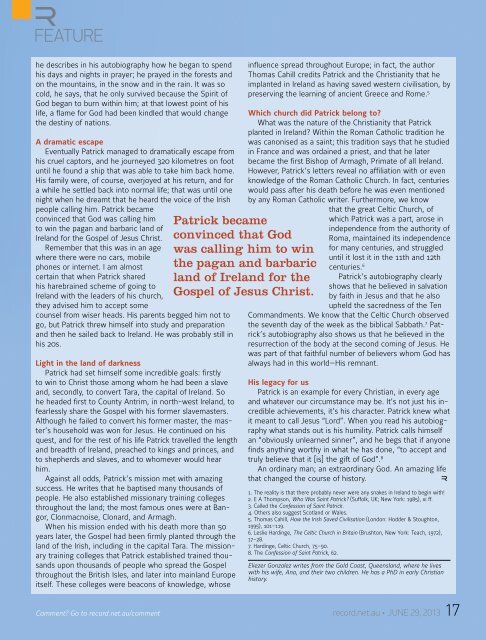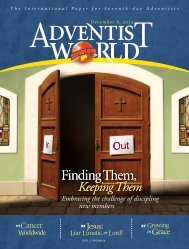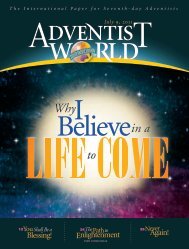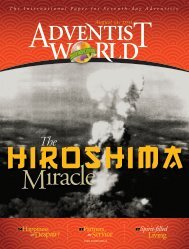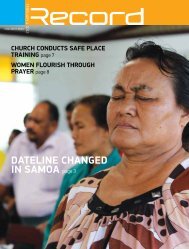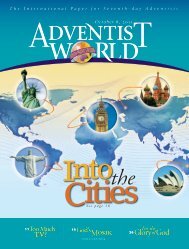Teenage girls find real beauTypage 7 - RECORD.net.au
Teenage girls find real beauTypage 7 - RECORD.net.au
Teenage girls find real beauTypage 7 - RECORD.net.au
- No tags were found...
You also want an ePaper? Increase the reach of your titles
YUMPU automatically turns print PDFs into web optimized ePapers that Google loves.
FEATUREhe describes in his <strong>au</strong>tobiography how he began to spendhis days and nights in prayer; he prayed in the forests andon the mountains, in the snow and in the rain. It was socold, he says, that he only survived bec<strong>au</strong>se the Spirit ofGod began to burn within him; at that lowest point of hislife, a flame for God had been kindled that would changethe destiny of nations.A dramatic escapeEventually Patrick managed to dramatically escape fromhis cruel captors, and he journeyed 320 kilometres on footuntil he found a ship that was able to take him back home.His family were, of course, overjoyed at his return, and fora while he settled back into normal life; that was until onenight when he dreamt that he heard the voice of the Irishpeople calling him. Patrick becameconvinced that God was calling himto win the pagan and barbaric land ofIreland for the Gospel of Jesus Christ.Remember that this was in an agewhere there were no cars, mobilephones or inter<strong>net</strong>. I am almostcertain that when Patrick sharedhis harebrained scheme of going toIreland with the leaders of his church,they advised him to accept somecounsel from wiser heads. His parents begged him not togo, but Patrick threw himself into study and preparationand then he sailed back to Ireland. He was probably still inhis 20s.Light in the land of darknessPatrick had set himself some incredible goals: firstlyto win to Christ those among whom he had been a slaveand, secondly, to convert Tara, the capital of Ireland. Sohe headed first to County Antrim, in north-west Ireland, tofearlessly share the Gospel with his former slavemasters.Although he failed to convert his former master, the master’shousehold was won for Jesus. He continued on hisquest, and for the rest of his life Patrick travelled the lengthand breadth of Ireland, preached to kings and princes, andto shepherds and slaves, and to whomever would hearhim.Against all odds, Patrick’s mission met with amazingsuccess. He writes that he baptised many thousands ofpeople. He also established missionary training collegesthroughout the land; the most famous ones were at Bangor,Clonmacnoise, Clonard, and Armagh.When his mission ended with his death more than 50years later, the Gospel had been firmly planted through theland of the Irish, including in the capital Tara. The missionarytraining colleges that Patrick established trained thousandsupon thousands of people who spread the Gospelthroughout the British Isles, and later into mainland Europeitself. These colleges were beacons of knowledge, whosePatrick becameconvinced that Godwas calling him to winthe pagan and barbaricland of Ireland for theGospel of Jesus Christ.influence spread throughout Europe; in fact, the <strong>au</strong>thorThomas Cahill credits Patrick and the Christianity that heimplanted in Ireland as having saved western civilisation, bypreserving the learning of ancient Greece and Rome. 5Which church did Patrick belong to?What was the nature of the Christianity that Patrickplanted in Ireland? Within the Roman Catholic tradition hewas canonised as a saint; this tradition says that he studiedin France and was ordained a priest, and that he laterbecame the first Bishop of Armagh, Primate of all Ireland.However, Patrick’s letters reveal no affiliation with or evenknowledge of the Roman Catholic Church. In fact, centurieswould pass after his death before he was even mentionedby any Roman Catholic writer. Furthermore, we knowthat the great Celtic Church, ofwhich Patrick was a part, arose inindependence from the <strong>au</strong>thority ofRoma, maintained its independencefor many centuries, and struggleduntil it lost it in the 11th and 12thcenturies. 6Patrick’s <strong>au</strong>tobiography clearlyshows that he believed in salvationby faith in Jesus and that he alsoupheld the sacredness of the TenCommandments. We know that the Celtic Church observedthe seventh day of the week as the biblical Sabbath. 7 Patrick’s<strong>au</strong>tobiography also shows us that he believed in theresurrection of the body at the second coming of Jesus. Hewas part of that faithful number of believers whom God hasalways had in this world—His remnant.His legacy for usPatrick is an example for every Christian, in every ageand whatever our circumstance may be. It's not just his incredibleachievements, it's his character. Patrick knew whatit meant to call Jesus “Lord”. When you read his <strong>au</strong>tobiographywhat stands out is his humility. Patrick calls himselfan “obviously unlearned sinner”, and he begs that if anyone<strong>find</strong>s anything worthy in what he has done, “to accept andtruly believe that it [is] the gift of God”. 8An ordinary man; an extraordinary God. An amazing lifethat changed the course of history.1. The <strong>real</strong>ity is that there probably never were any snakes in Ireland to begin with!2. E A Thompson, Who Was Saint Patrick? (Suffolk, UK; New York: 1985), xi ff.3. Called the Confession of Saint Patrick.4. Others also suggest Scotland or Wales.5. Thomas Cahill, How the Irish Saved Civilisation (London: Hodder & Stoughton,1995), 101–119.6. Leslie Hardinge, The Celtic Church in Britain (Brushton, New York: Teach, 1972),17–28.7. Hardinge, Celtic Church, 75–90.8. The Confession of Saint Patrick, 62.Eliezer Gonzalez writes from the Gold Coast, Queensland, where he liveswith his wife, Ana, and their two children. He has a PhD in early Christianhistory.Comment? Go to record.<strong>net</strong>.<strong>au</strong>/commentrecord.<strong>net</strong>.<strong>au</strong> • June 29, 2013 17


